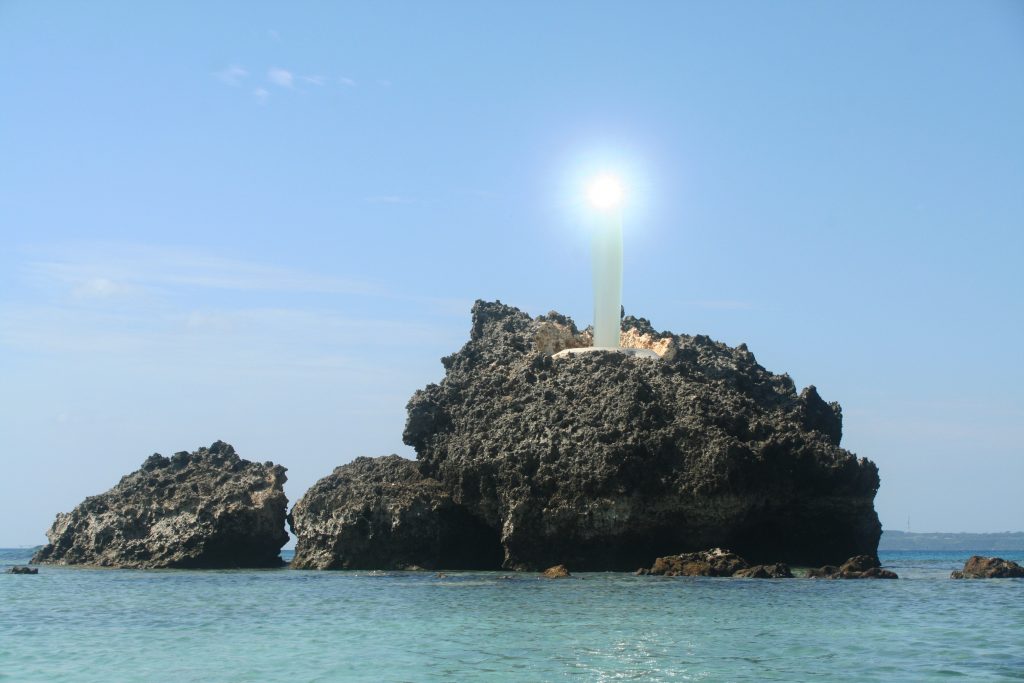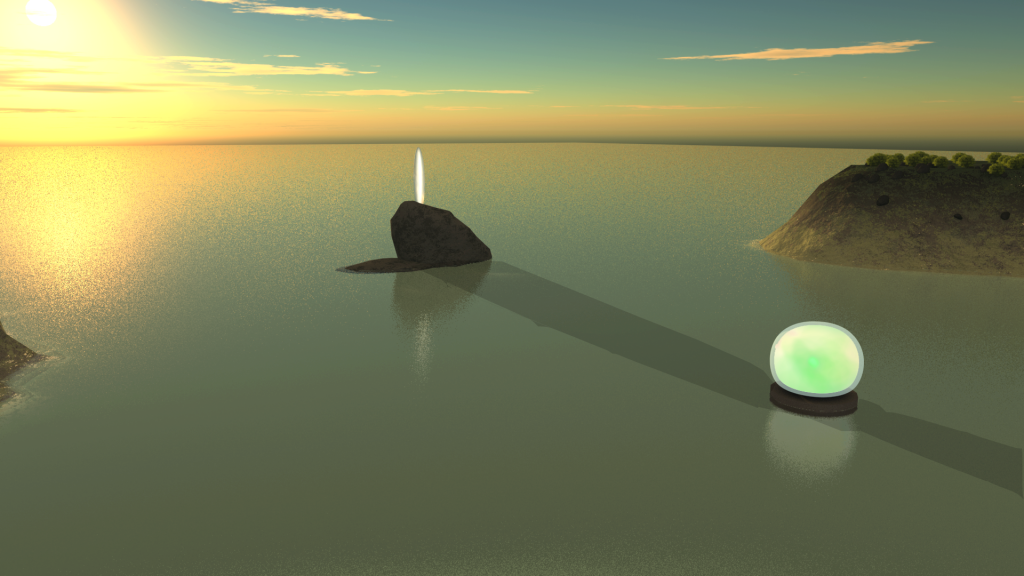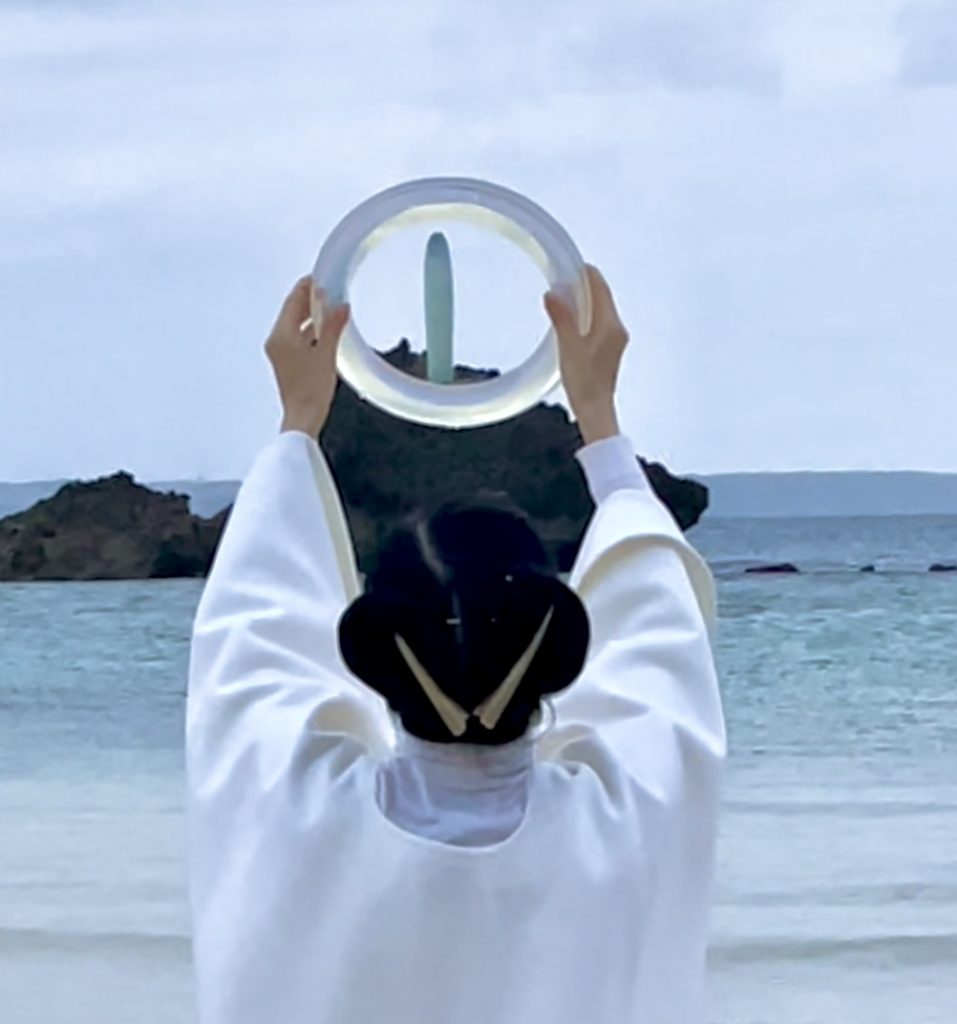by Sarah Bijlsma
At the north side of Miyako Island, from a rock in the sea a bit off coast, arises a pillar with a height of 4.2 meters. The pillar is narrow at its foot, widens a bit towards the middle and comes together at the top in a smooth and round shape. Its material could be that of a mineral or quarts; being partly transparent, the object merges with its surrounding environment as it takes on the color of the air behind it. Apart from the color, it reminds a little of an ancient megalith, like the statues of Stonehenge or the Moai on Easter Island. As such, it is not entirely clear whether this is a man-made shape or a natural geomorphological object. In any case, the pillar has certainly a spiritual atmosphere around it and could be an important object of worship in local religious traditions.

Photo credits: Toshiichi Shimoji
Courtesy Faou Foundation © Faou Foundation
The object I described above was created by the Japanese artist Mori Mariko (b. 1967, Tokyo) and part of the artwork Primal Rhythm.[1] Primal Rhythm is one of six site-specific artworks that will be placed on different continents. The statue Sun Pillar was put on the stack in July 2011 and made of layered acrylic; synthetic fibers with pigments in between that create different hues within the shape. The work further contains of a Moon Stone; a round stone-shaped object that floats on the surface of the sea and changes color according to the tide and the phase of the moon. Once a year, at the winter solstice, the Sun Pillar casts a shadow over the water that pierces the Moon Stone. Mori explains that she was inspired by artifacts found from the Jōmon Period (ca. 14.000 to 300 BCE). “Two objects were always found in a particular area: a round stone and a kind of small standing stone. The pair seems to me to be a symbol of regeneration, or a wish to help in harvest, or related to worship of the nature god. It’s probably a primitive stage of Shintoism.”[2]The Moon Stone, however, is not yet finalized, hence hitherto, the Sun Pillar glimmers alone on its rock formation.

Courtesy Faou Foundation © Faou Foundation
The location of Miyako Island for this artwork has not been chosen coincidentally. Mori “visited” Miyako via Google Earth and decided for Nanako Bay—referred to as “Seven Light Bay” by the artist—as the area seemed fairly untouched. Mori explains that some of the villagers who live nearby participate in annual rites where other islanders are not welcome. “[the rites are] quite hidden,” she says. “If you see [them], you will die. They’re really secretly done, these ceremonies. The island is very well-preserved. There is a rich indigenous community that still exists. Modern things not there so much but there is a lot to learn from them in terms of the relationship of human society to nature.” [3]

Courtesy Faou Foundation © Faou Foundation
In 2011, Mori invited the village shaman to perform a ceremony on the beach during the winter solstice in 2011. “They immediately understood what I am trying to do because they have such a rich relationship with nature,”[4] she states. Since then, Mori herself performs occasionally a ritual at the site, the most recent one during summer solstice this June. In white garment she spread her arms towards the Sun Pillar and let herself and a miniature version of the Moon Stone float on the waves of the sea.[5] In this regard, Primal Rhythm is indicative for the way how Miyako-jima is represented outside of the region, including assumptions on human-nature relationships and cultural purity that draw so many Japanese tourists and migrants near. Yet, more importantly, what this artwork also illustrates is how Seven Light Bay becomes a site where globalized concepts of place and indigeneity merge with local rituals and rites and where, accordingly, opportunities are created for new “traditions” to emerge.
“Journey to Seven Light Bay” (2013) by Mori Mariko
[1]
Visit for more information about the project its official website via https://www.faoufoundation.org/
[2]
Indrisek, Scott. “Crystal Flag: Mariko Mori wants to bring her nature-loving art to six continents.” Modern Painters, May 2011, pp. 58-93. (Here p. 60).
[3]
Ibid. pp. 60-61.
[4]
Ibid. 61.
[5]
See for videos of these rituals Mori Mariko’s Instagram page via https://www.instagram.com/marikomori/ and https://www.instagram.com/faoufoundation/
